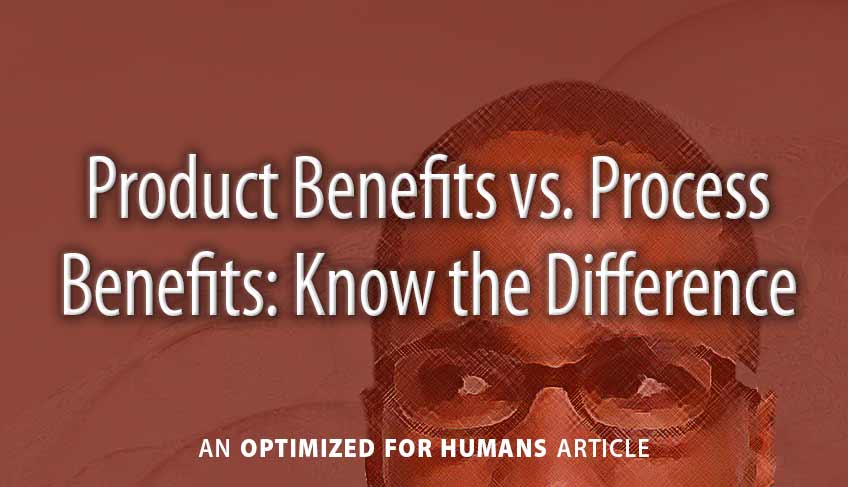
B Y T O M T O R T O R I C I
In a competitive marketplace, every company naturally wants to you to know why you should buy from them, and not the other guy.
Most of what we see and hear on websites, promotional emails, TV commercials, direct mail pieces, billboards and so on is devoted to these competitive benefits and what they ultimately mean to the buyer.
But in organizing and communicating these benefit points, it might be helpful to divide them into two buckets.
First, there are product benefits. These accrue to the buyer after the transaction is complete, and the customer is actually using the product.
For example, a lawn mower that mulches lawn clippings so you don’t have to rake and bag them. That certainly qualifies as a time- and labor-saving product benefit over other lawn mower models out there.
Another example are phones that offer wireless charging. Simply placing the phone on a charging pad at night offers a clear product benefit over having to keep plugging and unplugging it day after day after day.
Second, there are process benefits. These pertain to the purchase transaction itself, before the product is in the buyer’s hands.
One-click ordering is a good example of a smooth and simple process benefit.
Others include a product comparison guide or a chat line to help you choose; receiving reward points; a fast shipping option; warrantees or guarantees to reduce any risk; easy product assembly; financing options; and the holy grail of process benefits, free shipping.
Product benefits and process benefits are both important to the buyer. However they’re important at different times.
When you and I are in the early stages of a product search, we’re focused on two things: the pesky problem we’re trying to solve; and the wonderful solution we will soon enjoy. Chances are, that arc from one to the other, in our minds, has an emotional component: we feel bad about something (now) but look forward to feeling good about it (later).
Now, think of a web home page as the page for early-stage buyers, who are most likely first-time visitors. This is the place to promote the product benefits that help them mentally ride that arc. To make a visceral connection with them, match their emotionally-tinged search with emotionally-tinged messages.
As searchers move into the later stages of their search – and dig into a site’s interior pages – their priorities tend to shift.
Now that they’ve explored the broad possibilities out there for solving their issue, they start paying closer attention to how to get that wonderful product into their hands. If you pay attention to your own behavior when you’re on a mission to buy, you’ll see this is true.
The warrantee that you weren’t really thinking about before now takes on more importance. If one vendor lets me choose the product color, and another vendor randomly chooses a color for me, well, the first one clearly offers a benefit with regard to the ordering process.
In any case, the buyer at this point has pretty much shifted from emotional-mode to logical-mode, so logical appeals tend to work better here.
Companies who don’t get this difference all tend to make the same mistake.
And that mistake is, they put their process benefits up front on their home page, where the product benefits ought to be.
Why? Because as employees or managers, the ‘process’ is the part that they’re involved in and personally most familiar with. They’re not around when the buyer opens their box and gleefully starts using the product. That’s just not part of their own experience, so it’s not top-of-mind when they’re assembling their website copy.
So – an excited potential buyer lands on their site looking for the coolest new speedboat with all the latest high-tech features, but the first thing they see, the main banner headline on the home page is about – “easy financing.” Not an unimportant ‘process’ point ultimately, but that buzz kill creates a momentary disconnect, causing them to glance over at the back button to maybe … see what else is out there.
Don’t let that happen to you. Know the difference between product benefits and process benefits, and be sure to present each at the right time.
Where there are rules, though, there are exceptions. If you’re selling large or bulky items, you know that shipping costs are already on the minds of buyers, so offering free shipping might still be a good idea, perhaps as a secondary benefit point right on your home page.
Here, as in all marketing, understanding your buyers and what’s important to them (before they land on your site) is the key to engaging them, persuading them, and converting them.
Share It:
 About the Author: Tom Tortorici is an Atlanta copywriter and web content writer who helps companies make a genuine connection with their audience. His classes and conference presentations have focused on how writing, strategy and design can work together to grab attention and interest even among readers with short attention spans. In addition to working directly with businesses, Tom regularly partners with web designers and marketing agencies.
About the Author: Tom Tortorici is an Atlanta copywriter and web content writer who helps companies make a genuine connection with their audience. His classes and conference presentations have focused on how writing, strategy and design can work together to grab attention and interest even among readers with short attention spans. In addition to working directly with businesses, Tom regularly partners with web designers and marketing agencies.
All Posts/Subscribe >
Info for Businesses >
Info for Designers/Agencies >
Tom Tortorici Inc. | Tom@TomTortorici.com | 770-934-7861 | 3101 Rockaway Rd | Atlanta GA 30341
